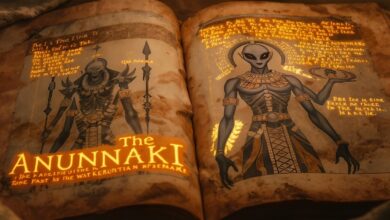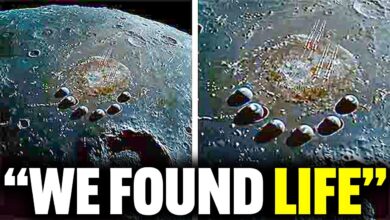The Great Pyramid Mystery: The Oldest Cover-Up In History

In 1993, German engineer Rudolph Gantenbrink went inside the Great Pyramid of Giza to study an unexplored shaft in the Queen’s Chamber. What was special about this shaft was that it did not open outward like the other shafts in the King’s Chamber, but instead extended about 10 feet (about 3 meters) into the wall and ended at a sealed point. As a result, the purpose of this shaft remains a mystery.
To learn more, Rudolph invented a small robot equipped with a camera and light that could fit into the narrow shaft, which was only about 8 inches (20 centimeters) wide. When the robot was inserted into the shaft, instead of reaching a stop as expected, they discovered that the shaft actually continued further and then rose at a 40-degree angle, leading to a new, previously undiscovered section. After traveling another 90 yards, the robot encountered a small limestone door with two bronze handles – a material that had never been found inside the pyramid before.
This discovery puzzled Rudolph and his team, as metal had never been found in the pyramid, which was believed to be made entirely of limestone. This led to the question of whether the door was placed after the pyramid was built, or was it placed there to protect something behind it? Rudolph sought permission from the Egyptian authorities to continue his research, but was unfortunately denied.
The history of the Great Pyramid of Giza is still full of theories. The official view is that the pyramid was built about 4,500 years ago as a tomb for the Pharaoh Khufu, although no mummies have ever been found in this or any other pyramid. These theories are based largely on circumstantial evidence and unproven assumptions. Even the name Khufu found inside the pyramid is only painted in red paint, which may have been painted long after the pyramid was built.
When looking at the size and precision of the pyramid, many people begin to doubt what we have been taught about history. The Great Pyramid of Giza consists of 2.3 million limestone blocks, some weighing as much as 80 tons, cut and transported from a distance of about 500 miles. Even building the pyramid in 20 years with primitive tools such as pulleys and ropes made from reeds seems impossible when compared to modern technology.

Research into how the Egyptians cut stone with such precision and how they built monuments as large as the pyramids remains a challenge. Many theories and practical tests have shown that the use of bronze tools to cut stone was ineffective, raising the question of whether the ancient Egyptians used technologies or methods that we do not yet fully understand.
Furthermore, the precision of the Great Pyramid of Giza, from its near-perfect alignment with magnetic north to its location at the exact geographic center of the Earth’s continents, has led many to question the capabilities of the ancient Egyptians and the true purpose of this structure.
The Earth is not a perfect sphere; it bulges slightly at the equator due to its rotation. This distortion means that the Earth is wider at the equator than it is from pole to pole. When measuring the base of the Great Pyramid, two measurements can be taken: one including the pyramid’s foundation (sockle) and one without. Without the sockle, the perimeter of the pyramid closely matches the length of one square minute of latitude (north-south line), while with the sockle, it matches the longitude (east-west line). This shows that the Great Pyramid is a scale model of Earth at a ratio of 1:43,200.
This ratio is significant, as multiplying the pyramid’s size by 43,200 would give a structure matching the size of the northern hemisphere of Earth. Remarkably, the accuracy is within 3 feet, which is as precise as possible given Earth’s constantly shifting forces, such as tidal and atmospheric influences, which affect its shape.
This number, 43,200, is not random. There are 43,200 seconds in a half-day (from sunrise to sunset), meaning the Earth rotates a distance equal to the pyramid’s perimeter every 2 seconds. Moreover, the Sun’s radius is 432,000 miles, and the Earth’s axial wobble moves 1 degree every 72 years, another multiple of 432. The resonant frequency inside the pyramid also aligns with the Earth’s natural vibrations at 432 Hz. These connections suggest the builders had a deep understanding of Earth’s geophysical and astronomical properties.
Theories about the pyramid’s purpose include Robert Bauval’s hypothesis from his 1994 book *The Orion Mystery*, which proposes that the three pyramids of Giza are aligned to mirror the stars in Orion’s Belt. When viewed from above, the positioning and sizes of the pyramids match Orion’s Belt, and the southern shaft of the Great Pyramid’s King’s Chamber points toward Orion’s Belt when rewound 4,500 years — the estimated time of the pyramid’s construction. This alignment is also observed in other pyramids across the world, such as in Teotihuacan, Mexico, suggesting that ancient civilizations globally shared advanced astronomical knowledge.
Additionally, electrical engineer Joe Parr conducted experiments from 1977 to 1987 on the Great Pyramid’s electromagnetic and radioactive properties. He found that when sending an alternating magnetic current through a pyramid-shaped model, it created an energy field, or bubble, that blocked external radiation, including gamma rays. Parr further discovered that by placing a centrifuge inside the pyramid model and spinning it rapidly, the pyramid became weightless and appeared to levitate. At its strongest, this energy bubble caused the pyramid to phase shift, temporarily disappearing and reappearing embedded in the room’s walls. Parr hypothesized that pyramid structures could enter “hyperspace,” potentially passing through physical objects under the right conditions.
Parr also noted that this energy field was strongest between December 12th and 16th each year, coinciding with a cosmic alignment between the Earth, Sun, and Orion’s Belt. This phenomenon further supports the connection between the pyramids and the Orion constellation.
Despite these discoveries, mainstream archaeology has not fully embraced these theories, which challenge conventional beliefs about ancient civilizations. Many researchers, like Parr and Bauval, argue that ancient societies had advanced technological knowledge, far surpassing what is typically taught in history. Evidence from other ancient sites, such as Göbekli Tepe, which dates back 11,500 years, suggests that these civilizations were more sophisticated than previously believed.
In conclusion, the Great Pyramid’s precise measurements, alignment with celestial bodies, and mysterious energy properties raise profound questions about the level of knowledge possessed by its builders. These findings challenge traditional views of ancient history and suggest that early civilizations may have had technologies and understanding that remain largely unknown to us today.








